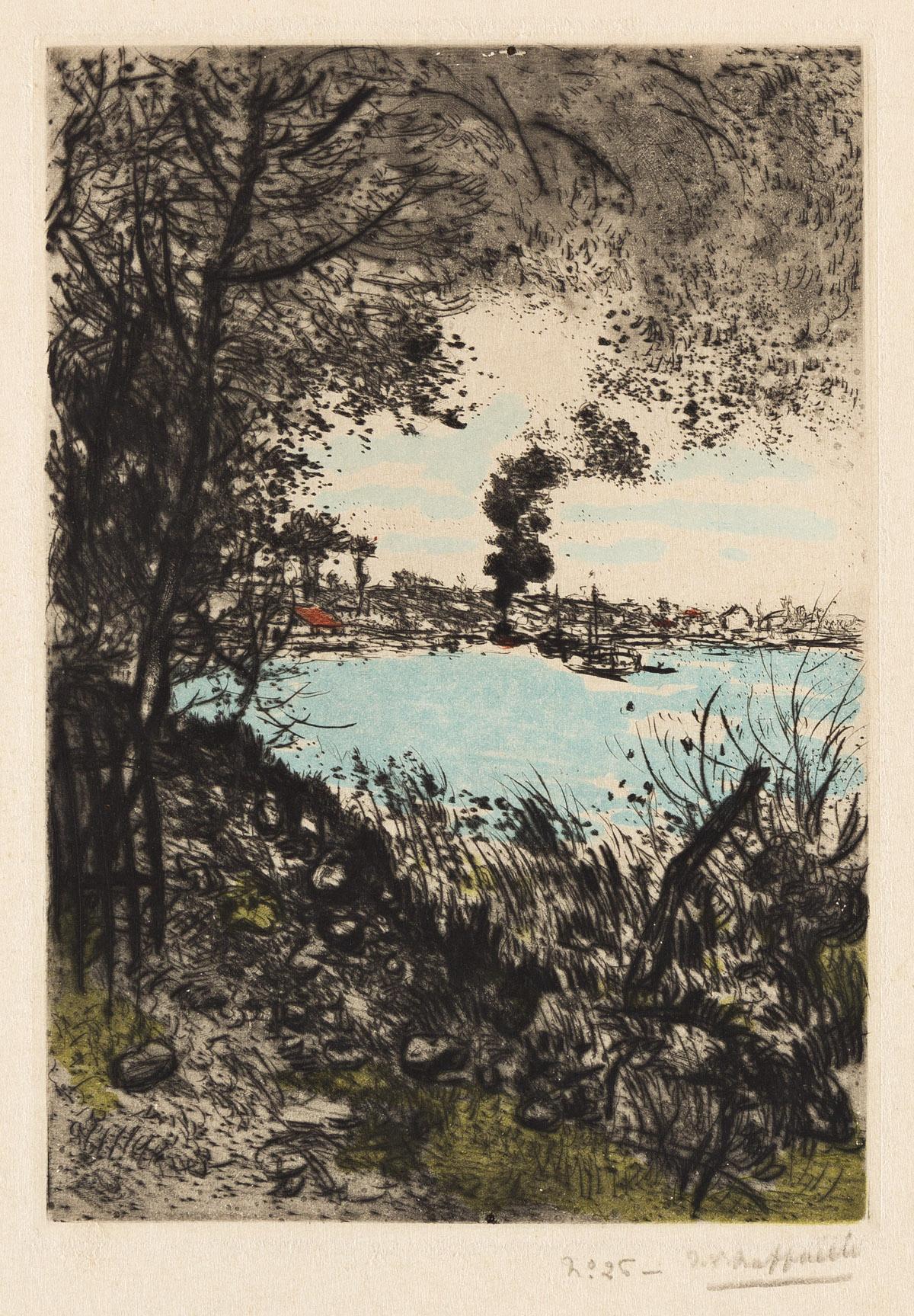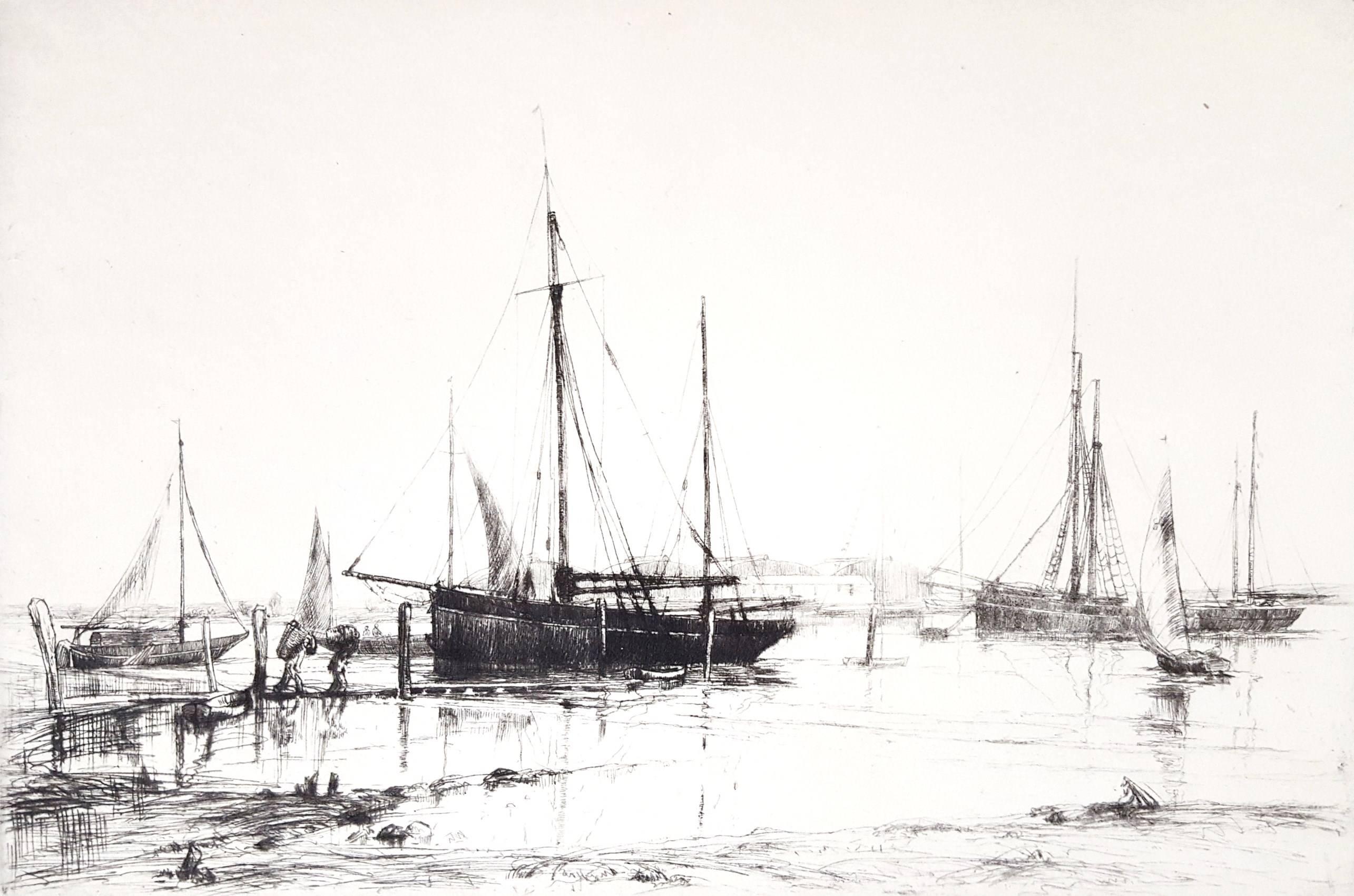Camille PissarroEffet de pluie by Camille Pissarro - Landscape etching1879
1879
About the Item
- Creator:Camille Pissarro (1831-1903, French)
- Creation Year:1879
- Dimensions:Height: 6.26 in (15.9 cm)Width: 8.39 in (21.3 cm)
- Medium:
- Movement & Style:
- Period:
- Condition:
- Gallery Location:London, GB
- Reference Number:1stDibs: LU261214154982
Camille Pissarro
Camille Pissarro was one of the most influential members of the French Impressionist movement and the only artist to participate in all eight Impressionist exhibitions.
Born in July of 1830 on the island of Saint Thomas in the Danish West Indies, Camille was the son of Frédéric and Rachel Pissarro. At the age of 12, he went to school in Paris, where he displayed a penchant for drawing. He returned again to Paris in 1855, having convinced his parents to allow him to pursue a career as an artist rather than work in the family import/export business. Camille studied at the Académie Suisse alongside Claude Monet, and, during this time, he met Paul Cézanne, Édouard Manet and Pierre-Auguste Renoir.
In 1869, Camille settled in Louveciennes. The outbreak of the Franco-Prussian War in 1870 prompted him to move to England, and, with Monet, Camille painted a series of landscapes around Norwood and Crystal Palace, while studying English landscape painting in the museums. Upon returning a year later at the end of the War to Louveciennes, Camille discovered that only 40 of his 1,500 paintings — almost 20 years’ work — remained undamaged.
Camille settled in Pontoise in the summer of 1871, remaining there and gathering a close circle of friends around him for the next 10 years. He reestablished relationships with Cézanne, Manet, Monet, Renoir and Edgar Degas, expressing his desire to create an alternative to the Salon, so that their group could display their own unique styles. Camille married Julie Vellay, with whom he would have seven children. Cézanne repeatedly came to stay with them, and, under Camille’s influence, he learned to study nature more patiently, even copying one of Camille’s landscapes in order to learn his teacher’s technique.
The first Impressionist group exhibition, initiated by Monet in 1874, earned the Impressionists much criticism for their art. While mainly interested in landscape, Camille introduced people — generally, peasants going about their rural occupations — and animals into his works, and they often became the focal point of the composition. It was this unsentimental and realistic approach, with the complete absence of any pretense, which seemed to stop his work from finding appreciation in the general public.
One of the few collectors who did show interest in Camille’s work was a bank employee named Paul Gauguin, who, after acquiring a small collection of Impressionist works, turned to Camille for advice on becoming a painter himself. For several years, Gauguin closely followed his mentor, and, although their friendship was fraught with disagreement and misunderstandings, Gauguin still wrote shortly before Camille’s death in 1906: “He was one of my masters, and I do not deny him.”
In the 1880s, Camille moved from Pontoise to nearby Osny, before Eragny, a small village much further from Paris. At a time when he was dissatisfied with his work, in 1885, Camille met both Paul Signac and Georges Seurat. He was fascinated by their efforts to replace the intuitive perceptive approach of the Impressionists with a “Divisionist” method, or scientific study of nature’s phenomena based on optical laws. Despite having reached his mid-50s, Camille did not hesitate to follow the two young innovators. The following year, he passed on this new concept to Vincent Van Gogh, who had just arrived in Paris and was keen to learn of the most recent developments in art. However, after a few years, Camille felt restricted by Seurat’s theories and returned to his more spontaneous technique while retaining the lightness and purity of color acquired during his Divisionist phase.
In the last years of his life, Camille divided his time between Paris, Rouen, Le Havre and Eragny, painting several series of different aspects of these cities, with varying light and weather effects. Many of these paintings are considered among his best and make for an apt finale to his long and prodigious career.
When Camille Pissarro died in the autumn of 1903, he had finally started to gain public recognition. Today his work can be found in many of the most important museums and collections throughout the world.
Find original Camille Pissarro art on 1stDibs.
(Biography provided by Stern Pissarro Gallery)
- ShippingRetrieving quote...Ships From: London, United Kingdom
- Return PolicyA return for this item may be initiated within 7 days of delivery.
- La rentrée du Berger by Camille Pissarro - EtchingBy Camille PissarroLocated in London, GBLa rentrée du Berger by Camille Pissarro (1830-1903) Etching 7.6 x 10.9 cm (3 x 4 ¹/₄ inches) Stamped with initials C.P. lower left, and numbered 13/18 lower right This work was crea...Category
1880s Impressionist Landscape Prints
MaterialsEtching
- Series - South of France by Lélia Pissarro, SerigraphBy Lelia PissarroLocated in London, GBSeries - South of France by Lélia Pissarro (B. 1963) Serigraph Image Size: 38 x 48 cm (15 x 19 inches) Sheet Size: 48 x 59 cm (18 ⅞ x 23 ¼ inches) Signed and numbered Printed in an edition of 300 SOLD UNFRAMED Artist's Biography Born in Paris in 1963, Lélia is the third and youngest child of Hugues-Claude and Katia Pissarro...Category
21st Century and Contemporary Impressionist More Prints
MaterialsScreen
- Paysage à Asquins by Paulémile Pissarro - Wood Engraving PrintLocated in London, GB*UK BUYERS WILL PAY AN ADDITIONAL 20% VAT ON TOP OF THE ABOVE PRICE SOLD UNFRAMED Paysage à Asquins by Paulémile Pissarro (1884 - 1972) Wood engraving 9.7 x 15.5 cm (3 ⁷/₈ x 6 ¹/₈...Category
20th Century Landscape Prints
MaterialsEngraving, Wood
- Kerfany by Ludovic-Rodo Pissarro - Wood engravingBy Ludovic-Rodo PissarroLocated in London, GBKerfany by Ludovic-Rodo Pissarro (1878-1952) Wood engraving 10.9 x 13.9 cm (4 ¹/₄ x 5 ¹/₂ inches) Initialled and titled in the plate Signed lower right, Ludovic Rodo and numbered low...Category
20th Century Post-Impressionist Landscape Prints
MaterialsEngraving
- Le Village de Landel by Paulémile Pissarro - etchingLocated in London, GBSOLD UNFRAMED Le Village de Landel by Paulémile Pissarro (1884 - 1972) Etching 17.2 x 23.7 cm (6 ¾ x 9 ⅜ inches) Signed lower right, Paulémile-Pissarro and numbered lower left, 2e e...Category
20th Century Post-Impressionist Landscape Prints
MaterialsEtching
- Veronique on the Pass by Lélia Pissarro - Coloured etchingBy Lelia PissarroLocated in London, GBVeronique on the Pass by Lélia Pissarro (b. 1963) Coloured etching 9.5 x 12 cm (3 ³/₄ x 4 ³/₄ inches) Signed lower left, Lélia Pissarro Numbered lower right, 1/15 Artist biography: Born in Paris in 1963, Lélia is the third and youngest child of Hugues-Claude and Katia Pissarro...Category
21st Century and Contemporary Landscape Prints
MaterialsColor, Etching
- La Fumée du BateauBy Jean Francois RaffaëlliLocated in New York, NYA very good impression of this color drypoint and aquatint. Third state (of 3). Edition of 150. Signed and inscribed "No. 25" in pencil, lower right.Category
1910s Impressionist Abstract Prints
MaterialsColor, Drypoint, Aquatint
- Narrow Street in Rouen (Petite Rue Nationale, a Rouen)By Camille PissarroLocated in New York, NYCamille Pissarro (1830-1903), Narrow Street in Rouen (Petite Rue Nationale, a Rouen), etching, drypoint, maniere grise, aquatint, 1896, signed in pencil lower right, numbered (No 6) ...Category
1890s Impressionist Landscape Prints
MaterialsDrypoint, Etching, Aquatint
- L’île Lacroix, à RouenBy Camille PissarroLocated in New York, NYCamille Pissarro (1830-1903), L’île Lacroix, à Rouen, etching, aquatint, maniere grise, drypoint, burnishing, c. 1887. Signed and numbered (No. 1) in pencil lower left, annotated 1...Category
1880s Impressionist Landscape Prints
MaterialsDrypoint, Etching, Aquatint
- Crab Boats, Southampton Water /// Impressionist British Seascape Ship MaritimeBy Aileen Mary ElliotLocated in Saint Augustine, FLArtist: Aileen Mary Elliot (English, 1896-1966) Title: "Crab Boats, Southampton Water" *Signed by Elliot in pencil lower right Circa: 1925 Medium: Original Drypoint Etching on laid p...Category
1920s Impressionist Landscape Prints
MaterialsDrypoint, Etching, Laid Paper, Intaglio
- BillingsgateBy James Abbott McNeill WhistlerLocated in Middletown, NYEtching printed in dark brownish black ink on cream laid paper, 6 x 8 7/8 inches (152 x 226 mm); full margins. Extremely minor and unobtrusive band of toning along the top sheet edg...Category
Mid-19th Century Impressionist Landscape Prints
MaterialsDrypoint, Laid Paper, Etching
- The Venetian MastBy James Abbott McNeill WhistlerLocated in Storrs, CTThe Venetian Mast. 1879-80. Etching and drypoint. Kennedy catalog 195 state .vi; Glasgow catalog 219 state x/xii. 13 3/8 x 6 3/8. Glasgow records 53 impressions. A fine, atmospheric...Category
1870s American Impressionist Landscape Prints
MaterialsDrypoint, Etching



